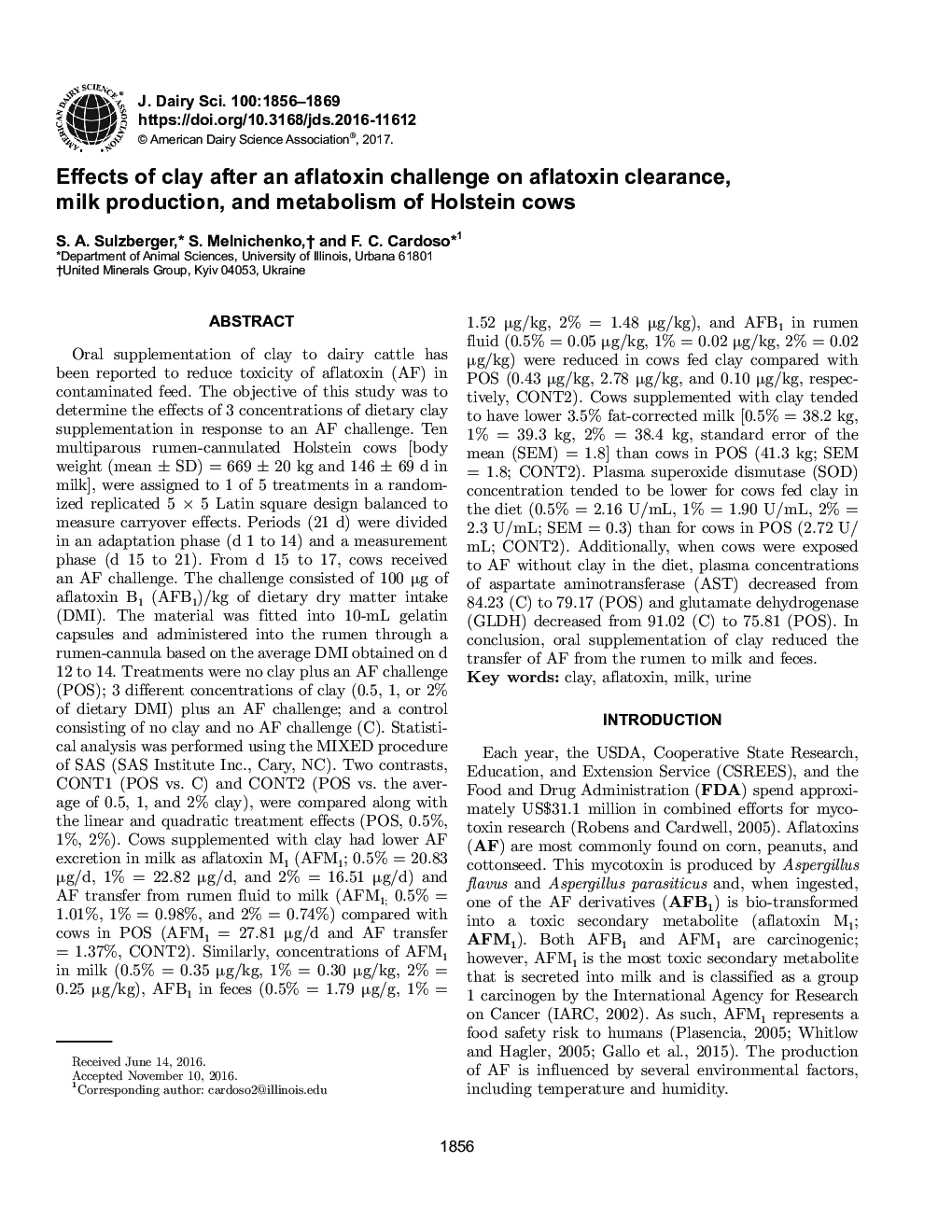| کد مقاله | کد نشریه | سال انتشار | مقاله انگلیسی | نسخه تمام متن |
|---|---|---|---|---|
| 5542491 | 1402519 | 2017 | 14 صفحه PDF | دانلود رایگان |
عنوان انگلیسی مقاله ISI
Effects of clay after an aflatoxin challenge on aflatoxin clearance, milk production, and metabolism of Holstein cows
ترجمه فارسی عنوان
اثرات خاک رس پس از یک چالش افلاتوکسین بر پاکسازی آفلاتوکسین، تولید شیر و سوخت و ساز بدن گاوهای هلشتاین
دانلود مقاله + سفارش ترجمه
دانلود مقاله ISI انگلیسی
رایگان برای ایرانیان
کلمات کلیدی
خاک رس آفلاتوکسین، شیر، ادرار
موضوعات مرتبط
علوم زیستی و بیوفناوری
علوم کشاورزی و بیولوژیک
علوم دامی و جانورشناسی
چکیده انگلیسی
Oral supplementation of clay to dairy cattle has been reported to reduce toxicity of aflatoxin (AF) in contaminated feed. The objective of this study was to determine the effects of 3 concentrations of dietary clay supplementation in response to an AF challenge. Ten multiparous rumen-cannulated Holstein cows [body weight (mean ± SD) = 669 ± 20 kg and 146 ± 69 d in milk], were assigned to 1 of 5 treatments in a randomized replicated 5 à 5 Latin square design balanced to measure carryover effects. Periods (21 d) were divided in an adaptation phase (d 1 to 14) and a measurement phase (d 15 to 21). From d 15 to 17, cows received an AF challenge. The challenge consisted of 100 μg of aflatoxin B1 (AFB1)/kg of dietary dry matter intake (DMI). The material was fitted into 10-mL gelatin capsules and administered into the rumen through a rumen-cannula based on the average DMI obtained on d 12 to 14. Treatments were no clay plus an AF challenge (POS); 3 different concentrations of clay (0.5, 1, or 2% of dietary DMI) plus an AF challenge; and a control consisting of no clay and no AF challenge (C). Statistical analysis was performed using the MIXED procedure of SAS (SAS Institute Inc., Cary, NC). Two contrasts, CONT1 (POS vs. C) and CONT2 (POS vs. the average of 0.5, 1, and 2% clay), were compared along with the linear and quadratic treatment effects (POS, 0.5%, 1%, 2%). Cows supplemented with clay had lower AF excretion in milk as aflatoxin M1 (AFM1; 0.5% = 20.83 μg/d, 1% = 22.82 μg/d, and 2% = 16.51 μg/d) and AF transfer from rumen fluid to milk (AFM1; 0.5% = 1.01%, 1% = 0.98%, and 2% = 0.74%) compared with cows in POS (AFM1 = 27.81 μg/d and AF transfer = 1.37%, CONT2). Similarly, concentrations of AFM1 in milk (0.5% = 0.35 μg/kg, 1% = 0.30 μg/kg, 2% = 0.25 μg/kg), AFB1 in feces (0.5% = 1.79 μg/g, 1% = 1.52 μg/kg, 2% = 1.48 μg/kg), and AFB1 in rumen fluid (0.5% = 0.05 μg/kg, 1% = 0.02 μg/kg, 2% = 0.02 μg/kg) were reduced in cows fed clay compared with POS (0.43 μg/kg, 2.78 μg/kg, and 0.10 μg/kg, respectively, CONT2). Cows supplemented with clay tended to have lower 3.5% fat-corrected milk [0.5% = 38.2 kg, 1% = 39.3 kg, 2% = 38.4 kg, standard error of the mean (SEM) = 1.8] than cows in POS (41.3 kg; SEM = 1.8; CONT2). Plasma superoxide dismutase (SOD) concentration tended to be lower for cows fed clay in the diet (0.5% = 2.16 U/mL, 1% = 1.90 U/mL, 2% = 2.3 U/mL; SEM = 0.3) than for cows in POS (2.72 U/mL; CONT2). Additionally, when cows were exposed to AF without clay in the diet, plasma concentrations of aspartate aminotransferase (AST) decreased from 84.23 (C) to 79.17 (POS) and glutamate dehydrogenase (GLDH) decreased from 91.02 (C) to 75.81 (POS). In conclusion, oral supplementation of clay reduced the transfer of AF from the rumen to milk and feces.
ناشر
Database: Elsevier - ScienceDirect (ساینس دایرکت)
Journal: Journal of Dairy Science - Volume 100, Issue 3, March 2017, Pages 1856-1869
Journal: Journal of Dairy Science - Volume 100, Issue 3, March 2017, Pages 1856-1869
نویسندگان
S.A. Sulzberger, S. Melnichenko, F.C. Cardoso,
